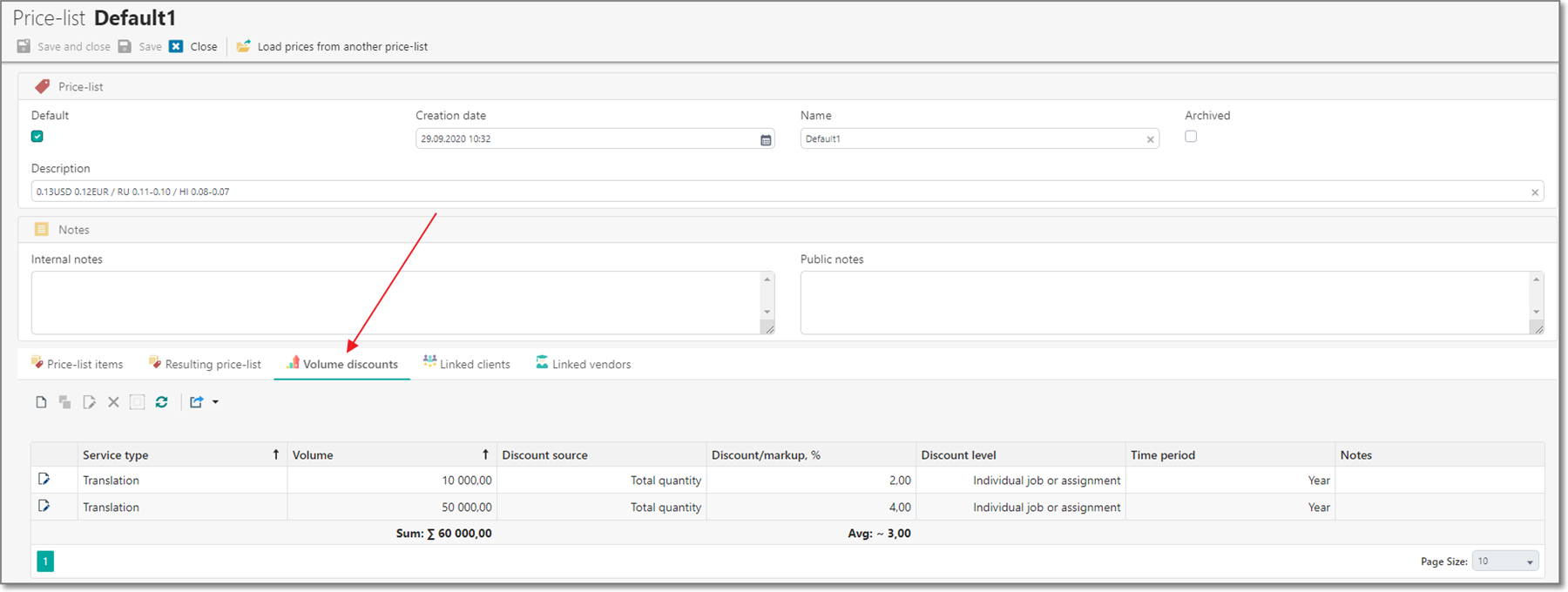Overview
TBM allows to configure flexible discount levels in your price lists. This article describes procedures used to create and apply volume discounts.
Discounts are created inside a specific price-list, which means that discount scheme may be applied in a certain job or assignment only when that price-list is active in that entity.
Creating discount scheme
To start, open any price-list and switch to the Volume discounts tab:
Here you can create any number of discounts, which may depend on a volume and a service type. Discount creation form has the following default look:

Service type. If non-blank, then discount will be applied only to a specified service. If blank, then a discount can be applied to any service. Be careful when leaving this field blank, because if you select Total quantity value in the Discount source field, then such configuration may lead to problems.
Volume. Quantity which must be achieved to apply a discount. You can create multiple discounts for different quantities (increase discount percentage with increasing a volume).
Discount source. Specifies how to calculate volume. For Total quantity application will take a value from the Quantity field (total number of words, hours, etc., without accounting fuzzies or multiple units from different service types).
Discount/markup %. Specify amount of discount. For markup, use positive values, while for discounts use negative values. For example, to provide 5% discount, enter '-5' in this field.
Discount level. Specifies a source to calculate volume used to identify if discount is applicable. Possible values:
- Individual task. Only task quantity defines possibility to apply a discount. In other words, quantity of a current task must exceed a value specified in the Volume field.
- Individual job or assignment. Total wordcount of individual job or assignment will be used as a base for discount applicability condition.
- Translation project. Total wordcount of all jobs or assignments in a current project will be used as a base for discount applicability condition.
- Client. Total wordcount for a current client will be used as a base for discount applicability condition.
- Language pair. Total wordcount for a selected language pair will be used as a base for discount applicability condition.
- Specialization. Total wordcount for a selected domain will be used as a base for discount applicability condition.
Time period. Specifies which time period should be taken when calculating total volume when Discount level has one of the following values: Client, Language pair or Specialization. Possible values:
- All time
- Year
- Quarter
- Month
- Week
- Day
When application will calculate total volume to find out if discount is applicable, this total volume will be taken from jobs (assignments) in a specified period back from a date of a job. Say, if you select Year value, then calculation will start from day of job minus 1 year.
Notes. A field for individual usage. Can also be used in reports.
Applying discounts
When you create a job or assignment, you select a client (vendor), and application loads default price lists of a selected client (vendor). Also, you can select specific price-list in the Price-list field (for example, when a client/vendor has multiple default price-lists, and you wish to use only a specific price-list). Then, application loads volume discounts from selected price-list(s). After that, when you create new tasks, application will automatically pick-up applicable discounts, and populate Discount/Markup and Discount notes fields. The latter will be populated with some generic value telling you which discount was automatically applied. Feel free to make manual changes in this field.

 Translate
Translate
